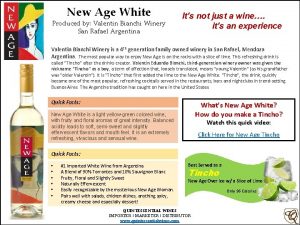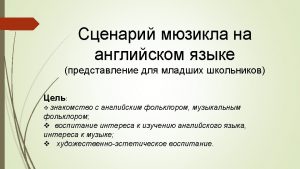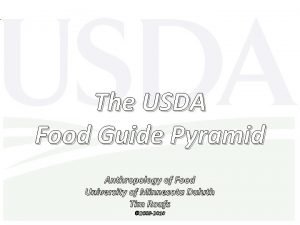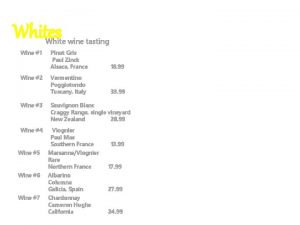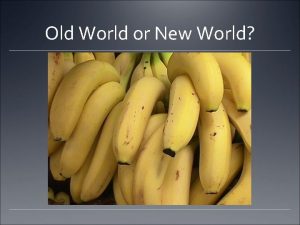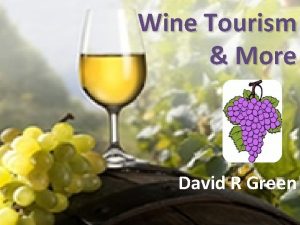Old World New World A Wine Education Seminar














- Slides: 14

Old World – New World A Wine Education Seminar John Marshall Chapter of the AWS May 2, 2010 Al Guber

Format Wine Regions of the World Wine Styles The Varietals The Blind Comparison

World Wine Regions Old World France Italy Spain Portugal Germany Remaining Europe S. Africa New World United States Australia New Zealand Chile Argentina

The Old World and the New

Wine Characteristics Old World New World Earthy Mineral Cedar/Tar Smoky Spicy Coffee Delicate Fruity Floral Oak Vanilla Spicy Chocolate Rich “Terroir” Driven Fruit Driven

Old World NW New World OW NW NW OW OW NW

What to Drink When?

The Varietals Chardonnay Pinot Noir Syrah Cabernet Sauvignon

Chardonnay Descriptors Different wine making techniques produce wide variances in the Chardonnay flavor profile. Such techniques as barrel fermentation, proportion of new to old cooperage, lees stirring, and partial, complete, or prevention of malolactic fermentation generate controversy and lively discussion among winemakers. Chardonnay's intrinsic sensitivity also allows its flavors to be dramatically affected by differences in soil, climate, and vineyard practices. Stone Fruits: apple, pear, peach, apricot Malolactic: butter, cream, hazelnut Citric Fruits: lemon, lime, orange, tangerine Oak (light): vanilla, sweet wood, coconut Tropical Fruits: pineapple, banana, mango, guava, kiwi Oak (heavy): oak, smoke, toast, lees, yeast Floral: acacia, hawthorn Terroir: flint, mint Old World Shorter growing season and cooler climate produce wines with generally crisp acidity, moderate alcohol. Focus on terroir aromas and flavors. New World CA/WA/AUS have the right conditions (long growing season) for creating richer styles: Rich/full body, butter/oak, moderate acid and alcohol. Oregon chardonnay tend to be lighter (Burgundy) in style.

Pinot Noir Descriptors Great Pinot Noir creates a lasting impression on the palate and in the memory. Its aroma can be intense with a ripe-grape, vaguely peppermint or black cherry aroma. Ripe tomato, mushroom, and barnyard are also common descriptors for identifying Pinot Noir. It is fullbodied and rich but not heavy, high in alcohol, yet neither acidic nor tannic, with substantial flavor despite its delicacy. The most appealing quality of Pinot Noir may be its soft, velvety texture. When right, it is like liquid silk, gently caressing the palate. Fruit: cherry, strawberry, raspberry, ripe tomato Terroir: mushroom, earth, barnyard, truffle, leather, meat Floral: violet, rose petal Oak (light): vanilla, coconut, sweet wood, coffee Spice: peppermint, rosemary, cinnamon, caraway Oak (heavy): oak, smoke, toast, tar Herbal: rhubarb, beet, oregano, green tomato, green tea, black olive Bottle Age: cedar, cigar box Old World Shorter growing season and cooler climate produce wines with more acidity, moderate alcohol. Focus on terroir aromas and flavors (mushroom, earth, leather, spice). New World CA (cooler coastal areas) long growing season good for creating richer styles: Rich/full body, big fruit (cherry), moderate acid and med to hi alcohol. Wide variation based on grape ripeness. Oregon Pinots tend to be more (Burgundy) in style, higher acid, lower alcohol.

Syrah Descriptors More than half the world's total Syrah acreage is planted in France, but it is also a successful grape in Australia (called Shiraz or Hermitage), South Africa and California. Syrah is a fairly new variety in California, first introduced in 1971. Some of the state's vines were propagated from Hermitage and some from Australian cuttings. It is also one of California's most rapidly increasing varieties. In 1984, there were less than 100 acres. Syrah now accounts for 12, 700 vineyard acres, almost half of which is less than three years old and not yet bearing fruit. Syrah requires heat to get fully ripe, but can lose varietal character when even slightly overripe. The berry is thick-skinned and dark, almost black. Syrah forms intense wines, with deep violet, nearly black color, chewy texture and richness, and often alcoholic strength, with aromas that tend to be more spicy than fruity. Fruit: black currant, blackberry Terroir: musk, civet, truffle, earth Floral: grass Oak (light): vanilla, coconut, sweet wood Spice: black pepper, licorice, clove, thyme, bay leaf Oak (heavy): oak, smoke, toast, tar Herbal: sandalwood, cedar Bottle Age: cedar, cigar box, earth, leather Old World Syrah is the only grape used to make the famous Rhône wines of Côte Rotie and Hermitage, but also forms the backbone of most Rhône/S. France blends, including Chateauneuf du Pape. Smoke, earth, leather, spice are often descriptors associated with these wines. New World One of California's most rapidly increasing varieties. In 1984, there were less than 100 acres. Syrah now accounts for 12, 700 vineyard acres, almost half of which is just beginning to bear fruit. Blackberry, jam, vanilla, and spice are often descriptors associated with these wines.

Cabernet Sauvignon Descriptors Cabernet Sauvignon makes the most dependable candidate for aging, more often improving into a truly great wine than any other single varietal. With age, its distinctive black currant aroma can develop bouquet nuances of cedar, violets, leather, or cigar box and its typically tannic edge may soften and smooth considerably. It is the most widely planted and significant among the five dominant varieties in the Medoc district of France's Bordeaux region, as well as the most successful red wine produced in California. Varietal Characteristics: Fruit: black currant, blackberry, black cherry Oak (light): vanilla, coconut, sweet wood Herbal: bell pepper, asparagus (methoxy-pyrazine), green olive Oak (heavy): oak, smoke, toast, tar Spice: ginger, green peppercorn, pimento Bottle Age: cedar, cigar box, musk, mushroom, earth, leather Old World Often blended with other varietals (merlot, cab franc, malbec, petit verdot). Bordeaux right bank (N)/left bank(S) determines the focus on Cabernet or merlot. Grapes and percentages vary from vintage to vintage. Long balanced flavor profiles with med acidity and focus on Terroir. New World Longer growing seasons may lead to more intense fruit, softer acids, and moderate to high alcohol. Generally fruit driven but vary depending on varietal make-up and growing conditions.

The Challenge Wine.

New World-Old World Comparison All wines are served blind. From each pairing, choose the old world and new world wine. Evaluate and be prepared to discuss decisions. We will proceed one varietal at a time poured in pairs. When all finished, we will reveal results. Have fun…
 Old world monkey vs new world monkey
Old world monkey vs new world monkey Are oranges old world or new world
Are oranges old world or new world New-old approach to creating new ventures
New-old approach to creating new ventures Njbta
Njbta Fresh oil new wine
Fresh oil new wine New age wine calories
New age wine calories Pre-membership education seminar (pmes) example
Pre-membership education seminar (pmes) example Seminar on education in india
Seminar on education in india Importance of seminar in education
Importance of seminar in education How old you
How old you Once upon a time there was a house with a man,
Once upon a time there was a house with a man, Once upon a time there lived an old man and an old woman
Once upon a time there lived an old man and an old woman Family
Family Difference between old covenant and new covenant
Difference between old covenant and new covenant Food pymarid
Food pymarid





